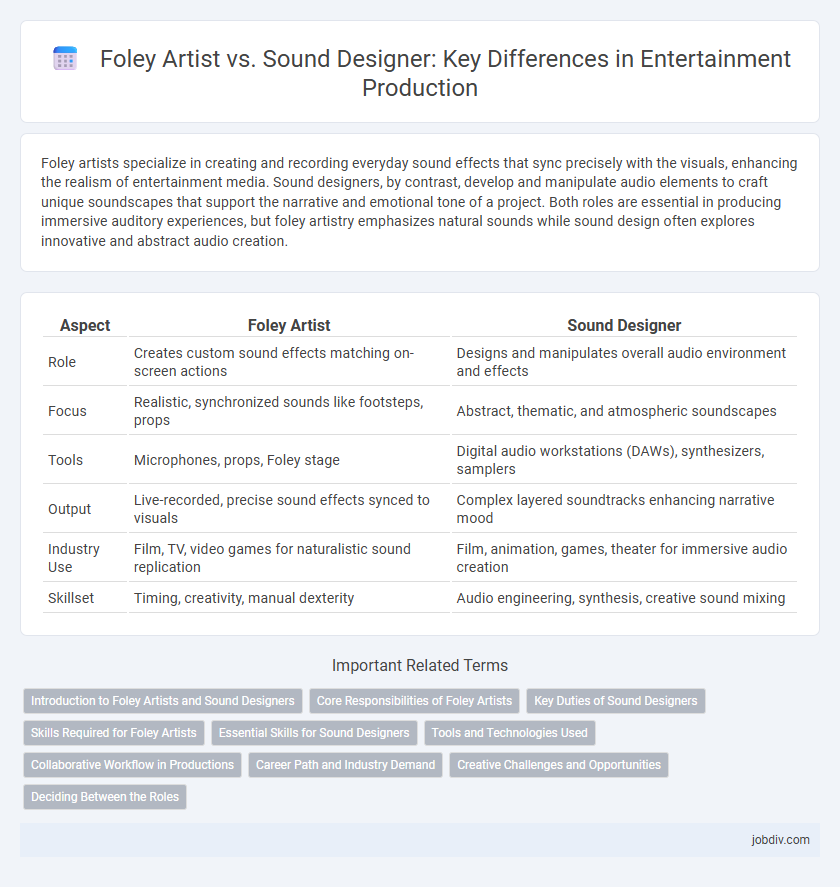Foley artists specialize in creating and recording everyday sound effects that sync precisely with the visuals, enhancing the realism of entertainment media. Sound designers, by contrast, develop and manipulate audio elements to craft unique soundscapes that support the narrative and emotional tone of a project. Both roles are essential in producing immersive auditory experiences, but foley artistry emphasizes natural sounds while sound design often explores innovative and abstract audio creation.
Table of Comparison
| Aspect | Foley Artist | Sound Designer |
|---|---|---|
| Role | Creates custom sound effects matching on-screen actions | Designs and manipulates overall audio environment and effects |
| Focus | Realistic, synchronized sounds like footsteps, props | Abstract, thematic, and atmospheric soundscapes |
| Tools | Microphones, props, Foley stage | Digital audio workstations (DAWs), synthesizers, samplers |
| Output | Live-recorded, precise sound effects synced to visuals | Complex layered soundtracks enhancing narrative mood |
| Industry Use | Film, TV, video games for naturalistic sound replication | Film, animation, games, theater for immersive audio creation |
| Skillset | Timing, creativity, manual dexterity | Audio engineering, synthesis, creative sound mixing |
Introduction to Foley Artists and Sound Designers
Foley artists create custom sound effects by recording everyday sounds to enhance the realism of film and television audio, focusing on footsteps, clothing rustle, and object interactions. Sound designers develop and manipulate audio elements using digital tools to craft atmospheric soundscapes, ambient noises, and unique effects that define a production's auditory identity. Both roles are essential in post-production, blending recorded and synthesized sounds to elevate the immersive experience of visual storytelling.
Core Responsibilities of Foley Artists
Foley artists specialize in creating and recording everyday sound effects such as footsteps, cloth rustling, and object handling to enhance the auditory realism of films and television shows. Their core responsibilities involve synchronizing these sounds precisely with the on-screen actions to ensure seamless audio integration. Unlike sound designers, who craft broader soundscapes and atmospheric audio elements, Foley artists focus on replicating natural sounds to support narrative immersion.
Key Duties of Sound Designers
Sound designers are responsible for creating, acquiring, and integrating all audio elements in a production to enhance the storytelling experience. They manipulate dialogue, effects, music, and ambient sounds to construct a cohesive soundscape that supports the narrative and emotional tone. Key duties include sound editing, mixing, designing original sound effects, and collaborating with directors to achieve the desired auditory impact.
Skills Required for Foley Artists
Foley artists require exceptional timing, creativity, and a keen ear for detail to replicate everyday sounds that sync perfectly with the visual on-screen action. Mastery in using various props and surfaces, coupled with an understanding of acoustics and sound properties, enables them to produce realistic and immersive audio effects. Strong collaboration skills are essential for working closely with sound designers and directors to enhance the overall auditory experience in film and television.
Essential Skills for Sound Designers
Sound designers must master audio engineering, creative sound synthesis, and precise editing techniques to craft immersive auditory experiences that enhance storytelling. Expertise in digital audio workstations (DAWs), sound libraries, and field recording are crucial for designing unique soundscapes. Strong collaboration skills and a deep understanding of narrative pacing empower sound designers to elevate the emotional impact of films and games.
Tools and Technologies Used
Foley artists use specialized tools like props, surfaces, and microphones to recreate everyday sounds that synchronize with on-screen actions, relying heavily on software like Pro Tools for capturing and editing these effects. Sound designers employ advanced digital audio workstations (DAWs) such as Logic Pro and Ableton Live, along with synthesizers, samplers, and plugins to create complex auditory environments and manipulate audio elements creatively. Both roles utilize cutting-edge technologies like spatial audio systems, Dolby Atmos, and sound libraries to enhance cinematic soundscapes and immersive experiences.
Collaborative Workflow in Productions
Foley artists and sound designers collaborate closely in entertainment productions to create immersive audio experiences by blending original sound effects with crafted atmospheres. Foley artists capture authentic, synchronized sounds like footsteps or cloth rustling, while sound designers manipulate and layer these elements with digital effects to enhance narrative impact. Their collaborative workflow ensures seamless integration of practical and synthesized audio, elevating the overall production quality and audience engagement.
Career Path and Industry Demand
Foley artists specialize in creating everyday sound effects using various props to enhance the realism of films and TV shows, often starting their careers with hands-on internships or apprenticeships in post-production studios. Sound designers develop complex audio landscapes including background scores, sound effects, and audio treatments, typically requiring formal education in audio engineering or sound production along with proficiency in digital audio workstations. The entertainment industry shows steady demand for both roles, with Dolby Atmos and immersive sound technologies driving growth in sound design, while Foley artistry remains essential for authentic, high-quality audio experiences in live-action projects.
Creative Challenges and Opportunities
Foley artists face the creative challenge of replicating everyday sounds to enhance realism, requiring precise timing and inventive use of objects to match on-screen action. Sound designers encounter broader opportunities to craft immersive auditory environments, blending synthesized sounds and recordings to evoke emotions and narrative depth. Both roles demand innovative problem-solving but differ in scope, with Foley artists rooted in performance and sound designers exploring abstract soundscapes.
Deciding Between the Roles
Choosing between a Foley artist and a sound designer depends on your passion for creating specific sound effects versus crafting the overall auditory experience. Foley artists specialize in producing realistic everyday sounds like footsteps and cloth rustling, essential for enhancing film authenticity. Sound designers focus on building immersive soundscapes and manipulating audio elements to shape mood and atmosphere, making their role vital in post-production creativity.
Foley Artist vs Sound Designer Infographic

 jobdiv.com
jobdiv.com